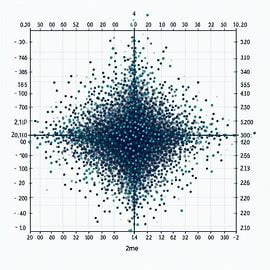In the realm of statistics, grasping the concepts of sample vs population is foundational, as is comprehending the various measures of central tendency that help us interpret data effectively.
Table of Contents
Sample vs Population
Population
The population refers to the entire group that you want to draw conclusions about.
Denoted by N.
For instance, if we are interested in the average height of all adults in a country, the population would encompass every adult in that country.
Sample
Sample on the other hand, is a subset of the population.
Denoted by n.
It’s a smaller group selected from the population that is used to gather information and draw conclusions about the entire population. Sampling is often necessary because it’s usually impractical or impossible to collect data from every single member of a population.
Outliers in data
Outliers are data points that significantly differ from other observations in a dataset. They are values that lie far outside the typical range of the majority of the data. Outliers can occur due to various reasons, including measurement errors, natural variability in the data, or genuinely unusual phenomena.
Example:
Imagine a dataset representing the heights (in centimeters) of students in a class:
160,165,162,163,161,300
Here, 300 cm stands out as an outlier compared to the other heights, which are in the range of 160-165 cm. This outlier could be due to a measurement error or it might represent an unusually tall student.

Measures of Central Tendency
Measures of central tendency are statistical measures that provide a single value representing the center of a data set. They are essential in summarizing data and understanding its characteristics. Here, we explore several key measures:

Mean
The mean is the arithmetic average of a set of values. It is calculated by summing all values and dividing by the number of values.
Example:
Consider the following ages of participants in a marathon: 28, 32, 30, 27, 29.
Mean = (28 + 32 + 30 + 27 + 29) / 5 = 146 / 5 = 29.2
Note: The mean is highly sensitive to outliers because it incorporates every data point in its calculation. A single extreme value can disproportionately affect the mean, pulling it towards the outlier’s value.
Median
The median is the middle value in a dataset when arranged in ascending order.
Case-1: For even number of observations
If there is an even number of observations, the median is the average of the two middle values.
Consider a race with 6 participants and their respective finish times (in seconds):
40,45,42,38,39,41
Step 1: Sort the data in ascending order:
Sorting the finish times gives us:
38,39,40,41,42,45
Step 2: Calculate the Median:
Since there are 6 observations (an even number), the median is the average of the two middle values.
Median=40+41 =81 =40.5
Case-2: For odd number of observations
When there is an odd number of observations, the median is simply the middle value in the sorted dataset.
Consider a race with participants and their respective finish times (in seconds):
40,45,42,38,39
Step 1: Sort the data in ascending order:
Sorting the finish times gives us:
38,39,40,42,45
Step 2: Calculate the Median:
Since there are 5 observations (an odd number), the median is simply the middle value.
Median=40
Note: The median is less affected by outliers because it only considers the middle value(s) of a dataset when sorted in ascending order. Outliers have no impact on the median as long as they don’t affect the position of the middle value(s).
Mode
The mode is the value that appears most frequently in a dataset.
Example:
Consider the outcomes of rolling a dice: 3, 5, 2, 6, 3, 4, 3.
So, Mode = 3 (since 3 appears most frequently).
Note: The mode is the most robust against outliers because it represents the most frequently occurring value(s) in a dataset. Outliers that occur only once or infrequently have minimal impact on the mode.

Weighted Mean
The weighted mean adjusts the average by giving different weights to different values based on their importance or frequency.
Example:
Suppose we have exam scores with different weightings:
Score 80 (weight 2), Score 90 (weight 3), Score 95 (weight 1).
Weighted Mean = (80*2+90*3+95*1) / (2 + 3 + 1) = (160 + 270 + 95) / 6 = 525 / 6 ≈ 87.5
Trimmed Mean
The trimmed mean excludes a certain percentage of the highest and lowest values to reduce the impact of outliers.
Example:
If we trim 10% from both ends of the dataset:
Data: 10, 15, 20, 25, 30, 35, 40, 45, 50
Trimmed Mean = (20 + 25 + 30 + 35 + 40) / 5 = 150 / 5 = 30
Conclusion
Understanding the distinction between sample and population is crucial in statistical analysis. Moreover, the effective use of measures of central tendency such as mean, median, mode, weighted mean, and trimmed mean allows us to summarize and interpret data accurately. Whether analyzing marathon times, exam scores, or income distributions, these statistical tools provide valuable insights into the characteristics of data and aid decision-making processes in various fields of study and research.
“If you’ve enjoyed this blog post and found it insightful, there’s more where that came from! Follow us to dive deeper into various topics, from statistics and data analysis to tips on personal development and beyond. Stay tuned for regular updates and fresh perspectives that aim to inform, inspire, and engage. Don’t miss out on the next installment—hit that follow button and join our community of learners and thinkers!”


